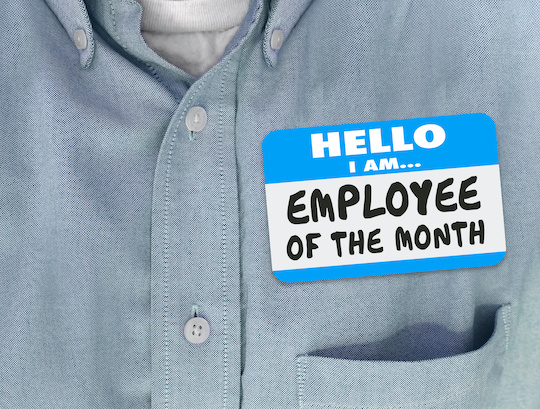When Employee Recognition Occurs, it Seldom Hits the Mark
- By
- Sam Jenniges, Contributor
- Posted
- Monday, July 5, 2021

A few years ago, I was a guest at a Fortune 500 company's celebration event to recognize five-year work anniversaries for several employees. With approximately 2,000 employees in attendance, this incredibly decorated venue included an open bar, appetizers, a sit-down dinner and party favors. There was an elaborate video created for the occasion highlighting the individuals' milestones, with a local celebrity emceeing. The Chairman & CEO spoke in person, and afterwards there was dancing with a live band. It was an elaborate, well-planned, generously budgeted, fabulous party.
Few companies have a budget to recognize five-year anniversary milestones—including an emailed company gift catalog—like this one. There may be even fewer of these type of events in the future.
I think that's a good thing. Read on to learn why.
When leaving the celebration, I had a conversation with the employee who invited me. It went something like this:
Me: Great party!
Employee: It was!
M: Amazing food, fabulous atmosphere, organized. Thoughtful!
E: They went all out.
M: The Chairman & CEO was there, plus a celebrity. Wow!
E: It's the first time I've been in the same room with the CEO.
M: The video must have taken weeks to produce.
E: It was impressive.
M: Do you feel recognized? Does this inspire you?
E: Do I personally feel recognized? Not really. But it was a GREAT party and a feel-good evening. I probably sound ungrateful for this huge night. I would have honestly preferred if my manager gave me a personal hand-written note acknowledging my anniversary and how important my work is to the team. That would have been more meaningful.
M: Hmmmm...
One healthcare executive echoed this sentiment and summed up the state of employee recognition this way:
"We do a lot with employee recognition, but like a lot of companies, it isn't always seen that way by employees."
This speaks to a major disconnect happening between organizations with good intentions and employees feeling recognized.
There are few things as powerful as the simple act of letting someone know their work made a difference. This was a profound statement I read during my research journey, and I have never forgotten it.
In partnering with clients across multiple industries, I found how rarely that simple yet powerful act is actually occurring.
When employee recognition occurs, it seldom hits the mark.
Good Intentions
Only 14% of companies provide the necessary training for recognition delivery.1 Human Resources professionals and leaders directing the work of others have been poorly served in the area of employee recognition. No wonder it's not occurring.
Whether it ranges from the elaborate — similar to the Fortune 500 company mentioned earlier — or to a simple, no-budget approach, most organizations do what others are doing when it comes to employee recognition. Besides a few creative nuances, we look to each other's common practices. That can be a really good thing. But what if those common practices are getting it wrong?
What if it's not the gift card, anniversary award, the mug, the public recognition, or the catered chicken dinner that is making the difference?
What if all that money, energy, and effort is wasted? According to Forbes, it largely is.
Employee recognition is estimated to be a $46 billion dollar market with 87% spent on tenure awards, though such rewards have little impact on an organization's performance.2
Why Are We Missing the Mark?
Somewhere along the way, we've lost sight of the goal of employee recognition:
To inspire individual employees to give their full effort, love working with you, and stay with you.
Here are three more reasons how we've dropped the ball of employee recognition:
We treat rewards the same as recognition. For many of us, when it comes to recognizing someone, one of our first thoughts tends to be about the reward. People love rewards. That's true, but too often the rewards become the recognition, and the recognition moment ends up with a short shelf life, largely missing the goal.
Peer recognition is a nice idea, but it typically exposes poor management because employees eventually think "Why doesn't my manager talk to me like this?"
The extrovert bias. Many people think recognizing a person must be done in front of other people. This can be the wrong approach. Roughly half the population is introverted and prefer not to be called out in front of others. Others may quite enjoy it. You might go wrong with public recognition, but you can't go wrong if you start with private—even the extroverts will love that.
How are you going to inspire people's full effort, help them love working with you, and stay with you if you are recognizing them ineffectively or doing things they don't like?
Why Recognition Matters
Why do we need to get employee recognition right, where employees actually feel personally recognized? Isn't just doing something good enough? Take a look at the research:
Prevent regrettable turnover. Employees who feel their work is unrecognized are twice as likely to quit in the next year.3
Improve Quality. Two-thirds of workers on effectively praised teams strongly agree that "quality is always a top priority" in their organization.4
Increase Productivity. Teams who received effective praise increased their productivity by 31%.5
It's the right thing to do.6
Manager Influence/Employee Preference
According to Gallup, 70% of a team's engagement depends upon the effectiveness of their manager7 — not the CEO, not HR, not a peer, not the company culture. The Manager. That's good news for managers because employees want to be recognized by them above all. In fact, employees report that the most meaningful recognition, in order, comes from:
- Their Manager
- A leader or CEO, then
- Their manager's manager, then
- Customers, then finally
- Peers
With all this manager influence and preference, it's clear that managers need to get good at delivering recognition.
When I coach managers and HR professionals in recognition, I know that in order to routinely and effectively recognize team members, these two things need to occur:
- It needs to feel easy.
- It can't feel like another "to-do" in already busy schedules.
To do this, I designed the TIPSS tool, and it transformed their approach immediately. Try it out below.
How Effective Recognition Is Done
Let's start with the criteria for recognition. One of your employees' work has made a valuable impact in some way. Big or small. It could be a book they recommended that helped your work, or it could be saving the company money. Recognize the employee using the TIPSS communication tool.
TIPSS
- Truthful, Timely — Did the work make a valuable difference? Be Truthful. If not, recognition is watered down. Being Timely matters, yet it's never too late.
- Impact of the work — What Impact did it have to you, someone else, or the company?
- Personal — Don't lump others in with the recognition. Stay Personal.
- Sincere — If you follow the other TIPS it will be Sincere.
- Specific — Be as Specific as you can so the employee knows you mean it.
How to deliver Recognition using TIPSS (any order)
Example Scenario:
Sofia helped train the new employee on the software SAP application which resulted in fewer data errors.
Example Language:
"Sofia, I want to thank you for training Ajay on the SAP app Monday and Tuesday. I know how busy you are, and Ajay told me how helpful you were. Thank you!" (T_PSS)
In this next version, notice the difference when you add Impact:
"Sofia, I want to thank you for training Ajay on the SAP app Monday and Tuesday. I know how busy you are, and Ajay told me how helpful you were. Because of your training, Ajay can easily access the system, and the data is more accurate for our HR team. Thank you so much!" (TIPSS)
Impact is the secret sauce that inspires. Impact is the one that helps others love working with you. Impact is the color that pops. Impact is the one that is most likely to retain your people. Impact allows you to reinforce what's important in your organization. Unfortunately, impact is usually missing during recognition.
There is everything right about wanting to build a team culture and celebrating rituals. It builds camaraderie, joy, and can even improve productivity. But call it what it is: Team Building. Otherwise it replaces recognition. Building a desired culture is helpful and necessary and a piece of the puzzle.
A desired culture is no match for a manager who routinely tells their individual employees specifically how their work had value.
Every HR professional I have spoken with in the past two years is looking for more. The time has come to get better at employee recognition and lose the outdated approaches that can actually be demotivating. The best part is it works just as well whether your team works remotely or not. Take two minutes to use the TIPSS tool today. Share it with those directing the work of others—and that includes parents and coaches, too.
Relying on an elaborate party, rewards, shout outs, peer recognition, or even getting the CEO to participate, is no match for a manager who gets good at this. Because leaders who get good at this have teams who give their full effort, love working with them, and stay with them.
Sam Jenniges is a Capability Builder and Recognition Rebel. She is the author of Recognition Rebooted, A Smarter Approach to Employee Recognition.
Notes
[1] http://go.globoforce.com/rs/globoforce/images/AberdeenReportNovember2013.pdf
[3] https://www.gallup.com/workplace/236441/employee-recognition-low-cost-high-impact.aspx
[4] https://www.gallup.com/workplace/329351/add-team-praise-employee-recognition-toolkit.aspx
[5] Achor, Shawn. The Happiness Advantage: The Seven Principles That Fuel Success and Performance at Work. New York: Crown Publishing Group, 2010
[6] Most everyone, everywhere.
[7] https://www.gallup.com/workplace/245786/gallup-reports-share-leaders-2019.aspx
[8] https://www.gallup.com/workplace/236441/employee-recognition-low-cost-high-impact.aspx
Go to eRep.com/core-values-index/ to learn more about the CVI or to take the Core Values Index assessment.

Sam Jenniges
Contributor
Sam Jenniges, M.S. is an Organizational Development Specialist, and author of Recognition Rebooted, A Smarter Approach to Employee Recognition. She is a culture builder, capability developer and retention strategist. She helps companies improve performance through their people by upskilling leaders in employee recognition, and coaching emergent leaders to inspire and keep their best people.
View additional articles by this contributor
Share This Article
Essentials
Additional Reading
Stay Updated
Employer Account Sign-up
Sign up for an employer account and get these features and functions right away:
- Unlimited Job Listings on eRep.com
- Applicant Search
- Applicant Tracking System (ATS)
- Unlimited Happiness Index employee surveys
- 3 full/comprehensive CVIs™
- No credit card required — no long-term commitment — cancel at any time
Write for eRep
Are you interested in writing for eRep? Read our submission guidelines.
